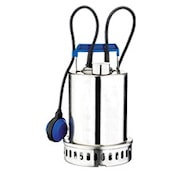Ebara Pump Blog |
 Selecting the appropriate submersible pump for your specific needs is crucial to ensure efficient and reliable water management. Here's a step-by-step guide to help you choose the right submersible pump: 1. Determine Your Water Needs:
0 Comments
 Maintaining submersible pumps is essential for their long-term efficiency and reliability. Here are some maintenance tips to help you keep your submersible pump in optimal condition: Regular Inspection:
 Calculating the proper cable size for a submersible pump installation is crucial to ensure the safe and efficient operation of the pump system. The cable size is determined by factors such as the pump's power requirements, distance between the pump and the power source, and voltage drop considerations. Here's a step-by-step guide for submersible pump cable calculations: 1. Determine Pump Power and Voltage:
 Calculating the specifications for a submersible pump involves several factors to ensure the pump's performance meets the requirements of your specific application. Here are the key parameters and steps involved in submersible pump calculations: 1. Total Dynamic Head (TDH): TDH is the total resistance or pressure that the pump needs to overcome to deliver water from the source to the destination. It is the sum of the following components:
3. Pump Efficiency (η): The efficiency of the pump, usually expressed as a percentage. It indicates how effectively the pump converts input power into hydraulic power. 4. Suction Lift (if applicable): If the pump is used for lifting water from a lower level, consider the suction lift, which is the vertical distance between the water level and the pump's intake. 5. Specific Gravity (if applicable): For applications involving fluids other than water, consider the specific gravity of the fluid. Steps to Calculate Submersible Pump Specifications:Calculate Total Dynamic Head (TDH):
Always refer to the pump manufacturer's documentation and guidelines for accurate and detailed pump selection and installation instructions. If you're unsure, consider consulting a professional engineer or pump specialist to ensure the proper selection and installation of the submersible pump for your specific needs. For more info contact ebara pump suppliers in uae or call us at +971 4 252 2966.  When it comes to the installation of submersible pumps, it is crucial to choose a reliable and reputable supplier. In the United Arab Emirates (UAE), one such trusted supplier of Ebara pumps is available. Ebara pumps are known for their high-quality and efficient performance in various applications, including water supply, drainage systems, and wastewater management. With their expertise in providing reliable pumping solutions, Ebara pump suppliers in the UAE play a vital role in ensuring successful installations. These suppliers offer a wide range of Ebara submersible pumps suitable for different requirements and environments. Whether it's for residential, commercial, or industrial purposes, they can provide the right pump that meets specific needs. Furthermore, these suppliers not only offer quality products but also provide valuable support throughout the installation process. They have knowledgeable staff who can assist customers in selecting the appropriate pump model based on their requirements and guide them through the installation procedures. In conclusion, when seeking submersible pump installation services in UAE, relying on reputable Ebara pump suppliers ensures access to high-quality products and professional support throughout the entire process. Installing a submersible pump involves several steps to ensure proper functionality and safety. Here's a detailed guide on how to install a submersible pump: Note: It's important to consult the manufacturer's installation manual and local codes before proceeding. Submersible pump installations may vary based on the specific pump model and the type of well you have. Materials and Tools Needed:
Installation Steps:Well Preparation:
 A circulation pump, also known as a circulator pump, is an essential component in various fluid transport systems. Its primary function is to circulate fluids within a closed-loop system, ensuring efficient transfer of heat or mass. This circulation maintains a uniform temperature or concentration throughout the system A circulation pump consists of several key components:
Applications:
Efficiency, Maintenance and SizingEfficiency and Control:
|
AuthorWrite something about yourself. No need to be fancy, just an overview. Archives
May 2024
Categories |
HoursMon-Sat: 8am - 6pm
|
Telephone+971 4 25 22 966
|
|
 RSS Feed
RSS Feed